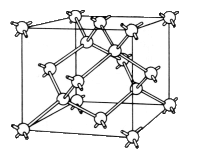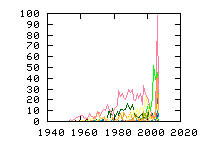« Previous
1
Next »
(12 hits, 1/1)
Showing
10, 25, 50, 100, 500, 1000, all papers per page.
Sort by:
last publication date,
older publication date,
last update date.
- 1. Appl. Phys. Lett. 90, 074101 (2007) , “Stacking fault generation during relaxation of silicon germanium on insulator layers obtained by the Ge condensation technique”, B. Vincent, J.-F. Damlencourt, V. Delaye, R. Gassilloud, L. Clavelier, and Y. MorStacking fault generation within silicon germanium on insulator substrates fabricated by the Ge condensation technique has been evidenced by transmission electronic microscopy analyses for high Ge content enrichments (80%). This phenomenon is explained as a typical strain relaxation mechanism... (Read more)
- 2. Appl. Phys. Lett. 90, 013116 (2007) , “Onset of stacking faults in InP nanowires grown by gas source molecular beam epitaxy”, D. M. Cornet, V. G. M. Mazzetti, and R. R. LaPierreInP nanowires (NWs) were grown by gas source molecular beam epitaxy on InP (111)B substrates, using Au nanoparticles as a growth catalyst. The rod-shaped NWs exhibited hexagonal sidewall facets oriented along the {−211} family of crystal planes for all NW diameters, indicating minimal... (Read more)
- 3. Appl. Phys. Lett. 89, 103519 (2006) , “Observation of a multilayer planar in-grown stacking fault in 4H-SiC p-i-n diodes”, Joshua D. Caldwell, P. B. Klein, Mark E. Twigg, Robert E. Stahlbush, Orest J. Glembocki, Kendrick X. Liu, Karl D. Hobart, and Fritz KubIn-grown stacking faults (IGSFs) are planar defects that do not propagate under either an applied optical or electrical bias; however, their effect upon the electrical characteristics of diodes is not well understood. We present evidence for a multilayered IGSF and discuss its electrical and optical... (Read more)
- 4. J. Appl. Phys. 100, 023512 (2006) , “Stacking faults and twin boundaries in fcc crystals determined by x-ray diffraction profile analysis”, Levente Balogh, Gábor Ribárik, and Tamás UngárA systematic procedure is developed to evaluate the density of planar defects together with dislocations and crystallite or subgrain size by x-ray line profile analysis in fcc crystals. Powder diffraction patterns are numerically calculated by using the DIFFAX software for intrinsic and extrinsic... (Read more)
- 5. J. Appl. Phys. 99, 011101 (2006) , “Degradation of hexagonal silicon-carbide-based bipolar devices”, M. Skowronski and S. HaOnly a few years ago, an account of degradation of silicon carbide high-voltage p-i-n diodes was presented at the European Conference on Silicon Carbide and Related Compounds (Kloster Banz, Germany, 2000). This report was followed by the intense effort of multiple groups... (Read more)
- 6. Phys. Rev. B 74, 233203 (2006) , “Combined photoluminescence-imaging and deep-level transient spectroscopy of recombination processes at stacking faults in 4H-SiC”, A. Galeckas, A. Hallén, S. Majdi, J. Linnros, and P. PirouzWe report on electronic properties of single- and double-layer stacking faults in 4H-SiC and provide an insight into apparent distinctions of recombination-enhanced defect reactions at these faults. Photoluminescence imaging spectroscopy and deep-level transient spectroscopy experiments... (Read more)
- 7. Phys. Rev. B 73, 115204 (2006) , “Platelets and the 110a0/4 {001} stacking fault in diamond”, J. P. Goss, P. R. Briddon, R. Jones, M. I. HeggieElectron microscopy reveals the presence of {001} platelets in annealed, nitrogen containing diamond. These extended planar defects give rise to a large displacement of the surrounding material, are correlated with luminescence and optical absorption, and are characterized by the B... (Read more)
- 8. Nature 430, 1009 (2004) , “Ultrahigh-quality silicon carbide single crystals”, Daisuke Nakamura, Itaru Gunjishima, Satoshi Yamaguchi, Tadashi Ito, Atsuto Okamoto, Hiroyuki Kondo, Shoichi Onda, Kazumasa TakatoriSilicon carbide (SiC) has a range of useful physical, mechanical and electronic properties that make it a promising material for next-generation electronic devices1,2. Careful consideration of the thermal conditions3-6 in which SiC {0001} is grown has resulted in improvements in crystal diameter and quality: the quantity of macroscopic defects such as hollow core dislocations (micropipes)7-9, inclusions, small-angle boundaries and longrange lattice warp has been reduced10,11. But some macroscopic defects (about 1–10 cm-2) and a large density of elementary dislocations (,104 cm-2), such as edge, basal plane and screw dislocations, remain within the crystal, and have so far prevented the realization of high-efficiency, reliable electronic devices in SiC (refs 12–16). Here we report a method, inspired by the dislocation structure of SiC grown perpendicular to the c-axis (a-face growth)17, to reduce the number of dislocations in SiC single crystals by two to three orders of magnitude, rendering them virtually dislocation-free. These substrates will promote the development of high-power SiC devices and reduce energy losses of the resulting electrical systems. (Read more)
- 9. Phys. Rev. Lett. 92, 175504 (2004) , “Driving Force of Stacking-Fault Formation in SiC p–i–n Diodes”, S. Ha, M. Skowronski, J. J. Sumakeris, M. J. Paisley, M. K. DasThe driving force of stacking-fault expansion in SiC p–i–n diodes was investigated using optical emission microscopy and transmission electron microscopy. The stacking-fault expansion and properties of the partial dislocations were inconsistent with any stress as the... (Read more)
- 10. J. Appl. Phys. 59, 3255-3266 (1986) , “Thermodynamic and Kinetic Considerations on the Equilibrium Shape for Thermally Induced Microdefects in Czochralski Silicon”, W. A. Tiller, S. Hahn, F. A. Ponce.Using thermodynamic and kinetic considerations, we explain the quasiequilibrium, morphological, and structural characteristics of thermally induced oxide precipitates in Czochralski silicon. A model based upon the formation of Frenkel defects at the silicon/silica interface is used to explain the... (Read more)
- 11. Physica B 116, 583-593 (1983) , “Investigations of well defined dislocations in silicon”, H. Alexander, C. Kisielowski-Kemmerich, E. R. WeberThe velocity v of dislocation half-loops introduced into swirl-free floating-zone grown undoped silicon has been measured at 420°C in the resolved shear stress range 30 <τ<300 MPa. Clearly impurity atoms interact with dislocations in this material. Using the starting value of v we found the two types of 60° dislocations, which are distinguished by the sequence of their partials, to have different velocities. Furtheron the velocity depends not only on τ, but also on the elastic strain of the lattice. In the second part the papers review EPR spectroscopy of plastically deformed silicon and collects new results on the activity of dislocations in this material as trapping / recombination centers (decay of photo-EPR, photoluminescence, EBIC microscopy and photoplastic effect). (Read more)
- 12. J. Phys. Chem. Solids 31, 1381 (1970) , “The Annealing of the EPR-Signal Produced in Silicon by Plastic Deformation”, F. D. Wohler and H. AlexanderW. SanderIn silicon an EPR signal is produced by plastic deformation. The annealing behavior of this signal has been investigated, and the dislocation density and structure has been studied by the etch pit technique and by electron microscopy. The EPR-signal anneals in one stage with an activation energy of... (Read more)
« Previous
1
Next »
(12 hits, 1/1)
Showing
10, 25, 50, 100, 500, 1000, all papers per page.
Sort by:
last publication date,
older publication date,
last update date.
All papers (3399)
Updated at 2010-07-20 16:50:39
Updated at 2010-07-20 16:50:39
(view as: tree
,
cloud
)
| 1329 | untagged |
Materials
(111 tags)
Others(101 tags)
Technique
(46 tags)
Details
(591 tags)
Bond(35 tags)
Defect(interstitial)(18 tags)
Defect(vacancy)(15 tags)
Defect-type(19 tags)
Element(65 tags)
Energy(8 tags)
Isotope(56 tags)
Label(303 tags)
Sample(17 tags)
Spin(8 tags)
Symmetry(15 tags)

